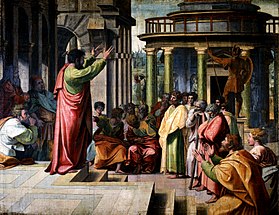Acts 17
It continues the second missionary journey of Paul, together with Silas and Timothy: in this chapter, the Christian gospel is preached in Thessalonica, Berea and Athens.
Paul, Silas and Timothy continued to travel westwards from Philippi on Via Egnatia, passing several cities before arriving at Thessalonica, which had "a well-established Jewish community with a synagogue" (verse 1), which Paul visited, "as was his custom", on three successive sabbaths to speak about the gospel (verse 2).
[11] That he was allowed to speak on three successive sabbaths gives an indication of "the respect commanded by his character as a Rabbi, and, it may be, by his earnest eloquence".
[16] Epicureans and Stoics are from two most dominant and popular schools of philosophy in Athens at that time (more than Academics and Peripatetics) and also with the greater contrast of teachings with the doctrines of Christianity, that Paul preached ("encountered" or "in conflict with", from Greek: συνέβαλλον, syneballon; cf.
[20][21] The Areopagus sermon is the most dramatic and fullest reported speech of the missionary career of Saint Paul and followed a shorter address in Lystra Acts 14:15–17.
[22] Paul explained concepts such as the resurrection of the dead and salvation, in effect a prelude to the future discussions of Christology.
[23] Τύμβον ἐτεκτήναντο σέθεν, κύδιστε μέγιστε, Κρῆτες, ἀεὶ ψευδεῖς, κακὰ θηρία, γαστέρες ἀργαί.

